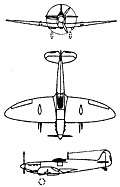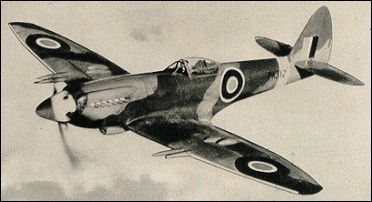|
| Without doubt the best known British aircraft of World War II, the Supermarine Spitfire originated
from the Type 224 designed by R. J. Mitchell to meet the requirements of Specification F.7/30. A cantilever low-wing monoplane of all-metal construction, it had an inverted-gull wing and 'trousered' fixed main landing gear, and was powered by a 447kW Rolls-Royce Goshawk II Vee engine. When the Type 224 was tested its performance proved disappointing, and it was no more successful than any of the other submissions to this specification; none of them gained an Air Ministry contract.
Given a free hand to design a new single-seat fighter unfettered by official specifications, Mitchell outlined on his drawing board the delightful Type 300. Smaller, sleeker and with drag-reducing retractable landing gear, it was tailored around the new Rolls-Royce P.V.12 (Merlin) engine; the wings were not only of distinctive elliptical shape, but they housed eight machine-guns, all of them firing outside the propeller disc. Air Ministry Specification F.36134 was drawn up around the Type 300 and a prototype was ordered. It was powered by a 738kW Rolls-Royce Merlin C and flew for the first time on 5 March 1936. Comparatively little flight testing was needed to confirm it as a winner, and its superb handling qualities and performance resulted in a first contract (for 310 Spitfire Mk I aircraft) being awarded on 3 June 1936. However, planned mass production was slow to gain momentum and it was not until July 1938 that the first Spitfire Mk I reached No. 19 Squadron at Duxford; only five had been delivered by the time of the Munich crisis in September of that year, but the trickle was eventually to become a flood that totalled 20,334 Spitfires and 2,556 related new-build Seafire naval fighters. A degree of multi-role capability was to result from the development of low-altitude clipped wings (prefix LF), and high-altitude increased-span wings (HF), the standard wing being identified as F, and with variations of armament within these wings comprising eight machine-guns (suffix A), two cannon and four machine-guns (B), four cannon (C) and two cannon, two 12.7mm machine-guns and up to 454kg of bombs (E).
By the outbreak of war on 3 September 1939, the RAF had nine operational Spitfire squadrons, and on 16 October 1939 a Spitfire of No. 603 Squadron claimed the first German aircraft to be destroyed over the UK in World War II, a Heinkel He 111. By August 1940, shortly before the Battle of Britain reached its climax, RAF Fighter Command could call upon 19 Spitfire Mk I squadrons. By December 1940 Spitfire Mk IIs were carrying out 'Rhubarb' sweeps over occupied Europe, and the first to serve overseas were Spitfire Mk VBs flown to Malta from HMS Eagle on 7 March 1942.
Soon after that date the same mark was operational in the Middle East, and by early 1943 the first Spitfire Mk Vs were arriving in the Pacific theatre. In growing numbers and with increasing capability the Spitfire served throughout World War II, not only with the RAF but with the nation's allies, including US and Soviet squadrons. It also had the distinction of remaining in production throughout the entire war and was operational post-war, the last mission flown by a photo-reconnaissance Spitfire PR.Mk 19 of No. 81 Squadron in Malaya on 1 April 1954.
 | A three-view drawing (592 x 919) |
| MODEL | Spitfire Mk VA |
| ENGINE | 1 x Rolls-Royce Merlin 45, 1102kW |
| WEIGHTS |
| Take-off weight | 2911 kg | 6418 lb |
| Empty weight | 2267 kg | 4998 lb |
| DIMENSIONS |
| Wingspan | 11.23 m | 37 ft 10 in |
| Length | 9.12 m | 30 ft 11 in |
| Height | 3.02 m | 10 ft 11 in |
| Wing area | 22.48 m2 | 241.97 sq ft |
| PERFORMANCE |
| Max. speed | 594 km/h | 369 mph |
| Ceiling | 11125 m | 36500 ft |
| Range w/max.fuel | 1827 km | 1135 miles |
| ARMAMENT | 8 x 7.7mm machine-guns |
| John Beavin, e-mail, 21.02.2011 10:01 I was a flight mechanic engines , my squadron had the mark 24s, ground attack fighter, they never gave much trouble, needed a plug change occasionally or a prop change, the pilots loved them, dumped for D H Hornets in 50 or 51. reply | | Col. Larry Guarino USAF ret, e-mail, 18.01.2011 22:50 I flew the Mk5B and C. Only difference that I recall was the B had a metal prop.Then I flew mostly the MkVIII and the MkVIIIC. The eight had pointed wingtips and blower cut in at 21,000 ft. The C had rounded tips and blower cutin at 14,000 ft.The US Army Air Corps had two groups, 6 squadrons flying the Spit from the landings in Africa to Anzio. Also flew most models of the P-51 to the K model. Cant compare the aircraft, both wonderful. Spit was basically an interceptor with limited range. The Mustang could fly from England to Berlin and back. reply | | Geoffrey Styles, e-mail, 16.12.2010 14:36 I am 81 years old. During WW2 I lived three miles from Hornchurch Aerodrome. My Dad took me there in 1938 for Empire Air Day. I remember the day it was bombed. My Dad worked in Hornchurch (WW1 veteran). We would go to the airfield gates and watch our heroes head out for R7R in London. Great chaps. We will never forget them. reply | | Martijn K., e-mail, 15.11.2010 15:40 Which planes are drawn on the previous page ? I see a: A10 (groundhog), a: flying boat (dornier perhaps ?), and there's a twin engined, inverted gull wing plane wich i'd like to know. Thanks in advance for reply. ps Nice site. reply | |
| | Robert Tobin, e-mail, 31.10.2010 07:43 I'm Australian, 70 years old and have loved Spitfires since I was a kid. I have the MS FS2009 Flight Simulator on my Computer and my Spitfre collection is my favorite.
I saw the reference to Squadron Leader J. R. Tobin. My name is Robert C. Tobin. I am probably not related to J.R. Tobin. I would love some information about this gentleman. reply | | Alphatango, e-mail, 30.10.2010 18:20 Guys, the speed of sound in air depends on temperature more than anything else. It's about 331.3m /s at 0 degrees C and 343m /s at 20 degrees C. The formula for local speed of sound is S = 331.5 + 0.6 x T (degrees C). Thus, the local speed of sound usually increases as the aircraft dives (and the local temperature increases) so that the aircraft becomes, once more, subsonic and therefore controllable. We don't have any data for the temperature at altitude during these incidents, but it could be assumed fall at around 2 degrees C per 1000' of altitude. The surface temperature in Hong Kong varies considerably, however, both seasonally and diurnally......... reply | | Alex Barbour, e-mail, 17.10.2010 02:26 Some years ago my friend Des McKenna( LLOYDS medal Chief Engineer MN WWll )and I were running a passenger tug up the Rideau River in Ottawa Ontario. It was Battle of Britain Day and just as we passed under the bridge for HuntClub we heard the noises we had both grown up with.
A Spitfire and a Lancaster Bomber coming from the eastern bank of the river where the air port sits above the river valley.
Unbelievable ------He remembered their noise from the days he ran ships in convoys in the Atlantic.
Me being younger, remembered them taking off on missions.
Most of the passengers had never heard them, nor heard of them.
Great Day. reply | | Ron, e-mail, 20.09.2010 06:27 Merlinmac,
The Mach .94 episode over Hong Kong by Ted Powles was in the early 1950s (1953 I think). I was passing on what I read, but if your sure I'm wrong, then I appreciate the correct info. I was thinking the wing was the new one like that in the picture (not saying the Mk in the photo).
I am aware that the earlier incident of Mach .891 has been reported as a Mk XIV or a Mk XI by different ones.
Sometimes the source has an obvious typo with an improper Roman numeral in the Mark. Keeps things mysterious I guess. reply | | Jef, e-mail, 12.09.2010 02:37 The spit that we have in our museum has a merlin engine made by packard with metric specs.
Jef reply | | Jef, e-mail, 12.09.2010 02:36 The spit that we have in our museum has a merlin engine made by packard with metric specs.
Jef reply | | merlinmac, e-mail, 10.09.2010 08:29 sorry finger trouble in my last comment it should be MKXIV not MKXVI reply | | Merlinmac, e-mail, 10.09.2010 08:25 Ron, you have your marks of Spifire mixed up , the picture above is of PK312 a MK22 with the re-designed wing,this aircraft was then retro-fitted with the Spiteful type tail as fitted to MK24's. The PRXIX you mention was essentially a MKXIV with arnament removed, F24 cameras,pressure cabin and a wet wing as fitted to the PRXI, it did not have the same wing as the late production MK21's, MK 22's & MK24's had. reply | | Ian Cognito, 29.07.2010 13:42 If you try to break the speed of sound at SL in a dive, you don't get to tell anyone about it. Even over Death Valley. reply | | Ron, e-mail, 29.07.2010 08:43 Ian,
Please explain your dive speed for Mach .891, I thought the ratio was 761.2 mph at SL for Mach 1. reply | |
| | grady stoodt, e-mail, 08.05.2010 16:58 i agree with gordon williamson. Ithink that the spitfire is the most beautiful plane ever to fly. I think of the spitfire as sort of a fighter version of the avro lancaster. or the other way around. reply | | Ron, e-mail, 28.08.2010 18:28 The calculation for the speed of sound changes with altitude.
The S.L. ratio is obviously level flight.
The question was: What is the ratio and altitude of your results, Ian? reply | | GARY, e-mail, 07.05.2010 18:32 THE "SPIT" WAS A BEAUTIFUL PLANE,WITHOUT A DOUBT!!! reply | | Ron, e-mail, 02.09.2010 08:05 Ian, you have a good point.
My posted ratio may work for level speed @ SL.
The Spitfire Mk 19 (with the new wing as pictured at the top) was surveying atmospheric conditions over Hong Kong when it lost control and dove from 51,550' recording 690 mph or Mach 0.94 terminal velocity. RAF pilot Ted Powles regained control and pulled out under 3,000' altitude, landing safely. But his data was regarded as highly questionable.
I don't know what altitude the max dive speed was recorded at. What was it for the (eliptacle wing) Mk XI when it reached 606 mph or Mach 0.891? The ratio is different. But then that one isn't in doubt so much either. reply | | David Samter, e-mail, 06.09.2010 08:49 For some beautiful flight scenes, get the dvd "Piece of Cake"..Story of an RAF squadron prior to and just after WWII started...Basically the movie ends at the beginning of the Battle of Britain...Another good movie is "Spitfire" aka "First of the Few", the bio of R.J. Mitchell... reply | | Smokey Beucus, e-mail, 04.01.2010 04:52 As far as looks go, the Spit is right up there with the Mustang. Saw a few while serving at Greenham Common in 1956, Jolly Good Show Mate. My hat is off to all the young men who flew this plane into combat and won the Air Battle over England. reply |
|
Do you have any comments?
|
| 
COMPANY
PROFILE
All the World's Rotorcraft
|







